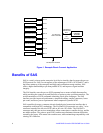
1 Intel® RAID Controller SRCSAS18E User’s Guide
1Overview
This chapter provides a general overview of the Intel
®
RAID Controller SRCSAS18E
with RAID control capabilities. It consists of the following sections:
• SAS Controller Description
• Configuration Scenarios
• Benefits of SAS
• Summary of SAS RAID Controller Features
• Hardware Specifications
The RAID Controller SRCSAS18E Storage Adapter is a high-performance intelligent PCI
Express*-to-SAS adapter with RAID control capabilities. The RAID Controller
SRCSAS18E provides reliability, high performance, and fault-tolerant disk subsystem
management. This is an ideal RAID solution for the internal storage of workgroup,
departmental, and enterprise systems. The RAID Controller SRCSAS18E offers a
cost-effective way to implement RAID in a server.
The SAS controller allows you to use SATA and SAS hard disk drives in the same system,
so you can take advantage of the benefits of each type of drive. Each controller can
connect up to eight drives directly and use expanders to connect to additional drives. See
the ANSI SAS standard, version 1.0 specification for more information about the use of
expanders.
As the second generation PCI Express storage adapter, the RAID Controller SRCSAS18E
addresses the growing demand for increased data throughput and scalability requirements
across midrange and enterprise-class server platforms. Simplified cabling between drives
is an additional benefit.
The innovative Intel
®
Portable Cache Module 2 for cached data protection allows system
builders to protect cached data even during the most catastrophic system failures.
The SAS controller supports the ANSI Serial Attached SCSI standard, version 1.0. In
addition, the controller supports the Serial ATA (SATA) protocol defined by the Serial
ATA specification, version 1.0a. Supporting both the SAS and SATA interfaces, the SAS
controller is a versatile controller that provides the backbone of both server and high-end
workstation environments.
Each port on the SAS RAID controller supports SAS and SATA devices using the SAS
Serial SCSI Protocol (SSP), Serial Management Protocol (SMP), and Serial Tunneling
Protocol (STP). The SSP protocol enables communication with other SAS devices.


















